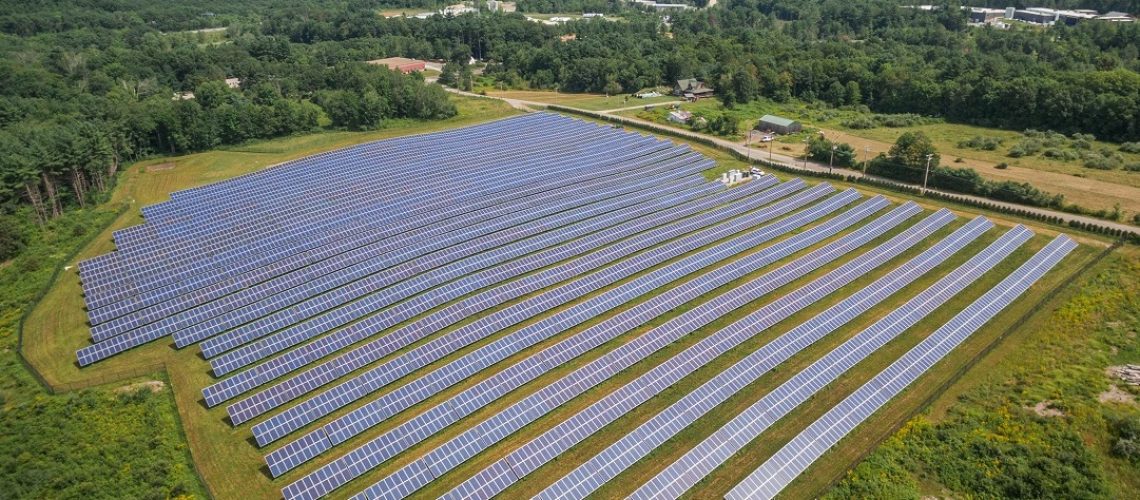Community solar has recently taken off, surpassing 7 GW of installed capacity in the U.S. and analyst firm, Wood Mackenzie, expects community solar installed capacity to essentially double in five years.
Community solar typically involves a customer subscribing to a portion of an off-site solar project’s generating capacity, receiving credits on their utility bills for the electricity produced by the facility. The Coalition for Community Solar Access (CCSA) noted that household names such as Microsoft, Google, Walmart, Starbucks, Rivian, Wendy’s, and T-Mobile are just a few of the Fortune 500 companies that have signed agreements with community solar developers.
Corporations are signing onto community solar for several reasons, the first of which is that they are looking to meet their clean energy and sustainability goals. Distributed energy projects, like community solar, are smaller projects that are located on the distribution side of the energy grid and are generally up and running much faster than utility-scale projects. Furthermore, many community solar projects have an environmental justice component, often bringing lower-cost energy to low-income residents and supporting this cause support corporations’ ESG goals.
While the companies can invest in many types of clean energy projects and receive renewable energy certificates (RECs) that help them meet sustainability goals, yet companies increasingly want to give back to their communities beyond just buying clean energy.
For example, Microsoft and Pivot Energy announced a five-year partnership to develop up to 500 MW of community-scale solar projects, which will produce more than 1 billion kWh of electricity annually, starting in 2025. The agreement is Pivot’s largest REC agreement to date. It also marks Microsoft’s first major distributed generation portfolio investment. Microsoft will purchase RECs generated by the projects for a 20-year term.
Microsoft, which has over 200 data centers worldwide, reports that it has a goal of covering 100% of those energy needs with renewable energy production by 2025, plans to be carbon negative by 2030 and says that by 2050 it will “remove our historical emissions since our founding in 1975.” In its 2022 Solar Means Business report, the Solar Energy Industries Association ranked Microsoft fifth on the list of corporate buyers of solar energy, joining Meta, Apple, Amazon and Walmart as leaders.
“An economy fueled by clean, distributed energy can do more than provide power at low cost; it drives growth and success in communities across the nation. This [collaboration] helps to build more inclusive, local economic growth across 100 communities while addressing the sustainability needs and opportunities within those communities,” said Adrian Anderson, GM, Renewables, Carbon Free Energy, CDR, Microsoft in its announcement with Pivot Energy.
Walmart also recently announced a partnership with Pivot Energy to invest in 19 solar projects in development across the U.S., including 15 community solar projects. The tax equity investment will support the construction, operation, and maintenance of solar projects in Illinois, Colorado, Maryland, Delaware, and California.
The investment from Walmart will facilitate 72 MW of community solar projects, 41 MW of which are located in Colorado and designed to serve low- and moderate-income homes. The community solar projects are expected to be completed in 2024 and 2025, serving an estimated 7,000 households and creating an estimated $6 million in annual savings for subscribers to the projects.
In March Walmart also extended and expanded upon its 2021 agreement with Nexamp, to create 26 community solar projects across six states that will produce enough electricity to support community solar subscriptions for about 13,000 residential households in the U.S. annually and enable approximately $8 million in annual bill savings.
In June, Ampion announced that Wendy’s will source between 30% and 100% of its energy from solar without the need to install solar panels onsite. Wendy’s plans to increase the number of restaurants enrolled in Ampion’s community solar program as additional solar generation capacity comes online and more franchise restaurants enroll in the program.
Last year, Wendy’s set near-term science-based targets to reduce absolute Scope 1 and 2 emissions by 47%, and Scope 3 emissions from franchisees by 47% per restaurant by 2030, from a 2019 baseline.Through Ampion, Wendy’s locations have enrolled approximately 27.5 million kWh in community solar or the equivalent electricity needed for 2,200 homes for one year. Each kilowatt hour will be accounted for, tracked, and assigned ownership to a specific restaurant location via RECs through the Ampion+ product.
“We are excited about the opportunity this partnership provides our Company and franchise restaurant operators by making it easier and more accessible to source clean energy while ultimately realizing cost savings,” said Steven Derwoed, vice president, global design & construction at Wendy’s. “We are advancing progress toward our emissions reduction goals through community solar participation and RECs. It’s a win-win for the Company and our franchisees.”
In July, Starbucks and Nexamp agreed to 40 MW of community solar projects in Illinois in which Starbucks will receive a portion of the renewable energy credits, with the remaining capacity of each project being allocated to over 1,100 residents and small businesses throughout the area. Rivian and Pivot also recently agreed to partner on community solar projects in Illinois, in which each MWac purchased also includes a $5,000 donation to locally sited community development organizations.
“Community solar gives companies, both large and small, the versatility to structure their participation in innovative ways to meet their business needs,” said Jeff Cramer, CEO of the CCSA. “While mom and pop stores are an important contingent of community solar subscribers, we’re now seeing some of the world’s largest corporations invest in community solar and other distributed generation projects — driving local clean energy and enabling much needed bill savings to communities most in need. The buy-in to community solar is now vast and varied, coming from the Department of Energy, Fortune 500 companies, and state legislatures across the country.”
Currently, 19 states and the District of Columbia have policies in place that permit third-party, competitive community solar development, while multiple states are advancing legislation to enable new programs.



